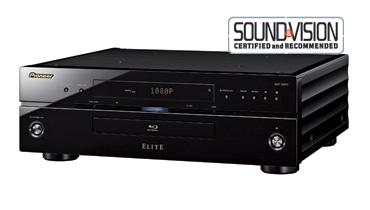Pioneer Elite BDP-09FD Blu-ray Disc player

| The Short Form |
| $2,200 / PIONEERELECTRONICS.COM |
| Snapshot |
| Pioneer's statement Blu-ray Disc player offers unparalleled features and perfor- mance - though at an unparalleled price |
| Plus |
| • Extensive, high-quality picture adjustments • Flawless DVD upconversion • Excellent multichannel analog-audio performance • Flexible setup options |
| Minus |
| • Expensive! • Slow to power up and load discs |
| Key Features |
| • BD Profile 2.0 • BD-Live ready via firmware update; 4 GB internal memory • Dual HDMI 1.3 outputs (16-bit Deep Color support) • 1080p/24 fps video output • Marvell QDEO video processing • Color-upsampling (4:4:4) output mode • Onboard Dolby TrueHD and DTS-HD Master Audio (via firmware update) decoding • Eight dual-mode Wolfson Audio DACs • Plays AVCHD and DivX discs • Connections: (2) HDMI; component-, composite-, and S-video; optical/coaxial digital audio, 7.1-channel analog audio, stereo analog audio; Ethernet port; RS-232C; minijack control input • 16½ x 6 x 14¼ in; 31½ lb |
Pioneer calls the BDP-09FD "BD-Live Ready." That means it has an Ethernet connection to hook up to your home network, although a firmware update is required to unlock BD-Live interactive features on discs. (Pioneer posted a firmware update to its support site in April that adds BD-Live along with DTS-HD Master Audio decoding.) The player also has two HDMI 1.3 connections - an arrangement that lets you do exotic things like send video directly to a TV or projector (along with 2-channel PCM audio) through the Main HDMI jack while routing multichannel soundtracks separately to an A/V receiver or processor over the Sub HDMI connection. When the player is connected to two different displays, its extensive menu of Custom picture adjustments - which include gamma correction, high- and mid-level sharpness and detail settings, and various noise-reduction modes - can also be applied separately to each output.
Pioneer touts the BDP-09 as a one-stop reference deck for music playback by way of CD, DVD, and Blu-ray Disc, which is why you'll find audiophile-targeted features like a dedicated analog-audio power supply and high-end Wolfson digital-to-analog converters for each of its 7.1 analog outputs. (Each DAC operates in dual mode, which Pioneer says effectively gives the player balanced-output capability.) And when it's hooked up by way of HDMI to one of Pioneer's new Elite-series receivers, the BDP-09's PQLS feature can bypass the HDMI interface's digital clock in favor of a high-speed reference clock located in the receiver - a step that improves CD sound quality by eliminating jitter.
Most people who would plunk down more than $2,000 for a BD player will be interested in its video performance, and the BDP-09 has serious cred in that department. Marvell's QDEO processor - a video upconverter that in my experience performs on par with the reference-quality Silicon Optix (now IDT) HQV chip - is onboard. Regular 8-bit video signals can also be interpolated to 16-bit depth and displayed in that format when the YCbCr 4:4:4 HDMI Color Space option is switched on and the player is connected to a Deep Color-compatible display. And an Anamorphic Zoom mode can vertically stretch widescreen images (to be later unstretched by an anamorphic-lens attachment) when using a front-projection setup with a 2.35:1 aspect-ratio screen.
Weighing in at nearly 32 pounds and standing nearly 6 inches tall, the BDP-09 has the heft and size of a serious piece of gear. Compared with other models with lesser build quality (meaning all of them), the disc tray looks and feels incredibly solid and stable as it glides in and out after you press the Open/Close button on the player's gloss-black front panel.
The glow-in-the-dark buttons on Pioneer's slender remote can help you locate a specific control in a dark room. Several of these provide quick access to features you'd normally have to root through onscreen menus to activate, including Output Resolution, which lets you switch between video-signal formats (including 1080p/24 and a Source Direct option that passes through the native video format encoded on the disc), and Video Adjust, which offers presets aimed at specific display types along with three custom picture-adjustment memories.
SETUP
The BDP-09FD has more audio/video setup options than I have space to cover here, so I'll stick with the basics. After connecting an HDMI cable from the player's Main HDMI output to my TV, I selected 1080p/24 output resolution, switched HDMI High Speed Transmission to the On position, and set Pure Cinema to Auto 1 mode. I also stored two custom picture memories in the Video Adjust menu - one with mild noise reduction and sharpness/detail adjustments for watching DVDs, and another to tone down Blu-ray movie transfers with aggressive edge enhancement.
Audio setup consisted of running six cables from the player's analog outputs to my Anthem AVM 50 pre/pro's multichannel input. I then selected the Analog Audio option from the Audio Out submenu, and Multi-channel from the Speakers submenu.
The BDP-09FD's other speaker setup options let you configure distance for individual speakers, set channel level (in 0.5-dB increments), and select a crossover point. (Pioneer's latest firmware update adds 50-, 80-, 100-, and 150-Hz options.)
- Log in or register to post comments




































































